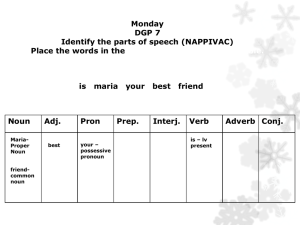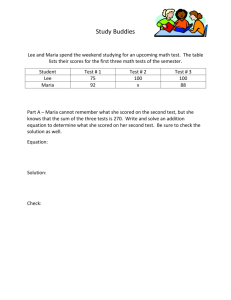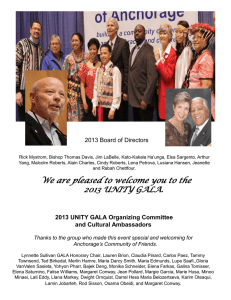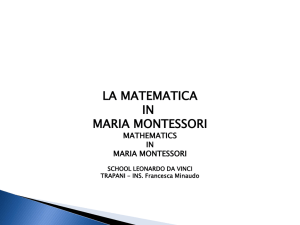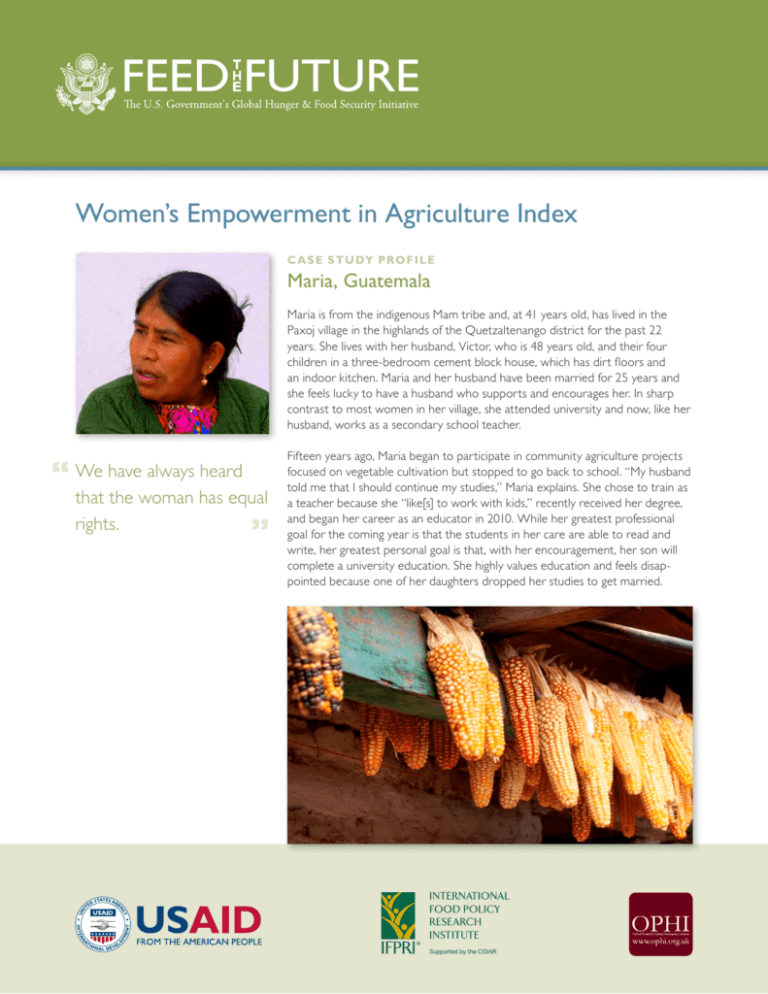
Women’s Empowerment in Agriculture Index
C a s e St u dy Pro f i le
Maria, Guatemala
Maria is from the indigenous Mam tribe and, at 41 years old, has lived in the
Paxoj village in the highlands of the Quetzaltenango district for the past 22
years. She lives with her husband, Victor, who is 48 years old, and their four
children in a three-bedroom cement block house, which has dirt floors and
an indoor kitchen. Maria and her husband have been married for 25 years and
she feels lucky to have a husband who supports and encourages her. In sharp
contrast to most women in her village, she attended university and now, like her
husband, works as a secondary school teacher.
We have always heard
that the woman has equal
rights.
Fifteen years ago, Maria began to participate in community agriculture projects
focused on vegetable cultivation but stopped to go back to school. “My husband
told me that I should continue my studies,” Maria explains. She chose to train as
a teacher because she “like[s] to work with kids,” recently received her degree,
and began her career as an educator in 2010. While her greatest professional
goal for the coming year is that the students in her care are able to read and
write, her greatest personal goal is that, with her encouragement, her son will
complete a university education. She highly values education and feels disappointed because one of her daughters dropped her studies to get married.
IFPRI
®
INTERNATIONAL
FOOD POLICY
RESE ARCH
INSTITUTE
Supported by the CGIAR
The Mayor of Paxoj makes the majority of decisions within
the community. Maria describes a leader as a “secure”
person, who can bring others together. While she would
like to be a leader, she does not think she has sufficient
time: “Right now I have to focus on things in my own
household.” She values spending time with her family and
explains that most women in her community similarly dedicate themselves to their households while most of the men
work in agriculture and construction. Maria enjoys tradition
and laments the customs in her area—including harvest
parties at the beginning of the season—that are being
slowly lost in younger generations.
Maria defines empowerment as an individual’s ability to
make decisions, like her neighbor, “who is always in all of
the community groups and does what he wants.” Unlike
some of the women in her community, who are disempowered by their husbands, Maria has felt empowered and
is proud of her university degree. Victor mirrors these sentiments, describing his wife as a “beautiful and hardworking
woman who understands and supports [me].”
To provide for household consumption, Maria and her
family only grow maize and keep small livestock. Victor
does the majority of the household’s agricultural work—
although the couple splits up the duty of caring for their
four pigs. Maria and Victor discuss all agricultural situations
before making decisions. In fact, all decisions regarding
assets, credit, and expenditures are made “between the
two of [them]…always, always.” According to Maria, family
communication is vital to securing a happy home, and, just
as decisions are made jointly, assets—both those owned by
her husband and those owned jointly between the two—
are shared for use with the entire household.
PRODUCTION
Input in
productive
decisions
Autonomy in
production
Ownership
of assets
Women’s Empowerment in Agriculture Index
Speaking
in public
Control over
use of income
CO
M
E
LE
AD
ER
S
H
IP
Copyright © 2012 IFPRI. All rights reserved. Photos: © 2012 Shafiqul Alam
Kiron. For more information, please visit www.feedthefuture.gov.
Group
member
IN
This innovative new tool is composed of two sub-indexes: one
measures how empowered women are within five domains,
and the other measures gender parity in empowerment within
the household. A woman is considered empowered if she has
adequate achievements in four of the five domains or in some
combination of the weighted indicators that reflect 80 percent
total adequacy. Gender parity reflects the percentage of women
who are as empowered as the men in their households.
Access to
and decisions
on credit
ES
Maria’s
Empowerment
Score
Workload
Purchase, sale,
or transfer
of assets
U RC
TI M
E
SO
Leisure
RE
Over the past year, Maria and Victor have spent the highest proportion of their money on medicine, followed by
clothing, and education fees for the children. Maria does
not believe that the individual who earns the most
income (in this case, Victor) should have more control
over household decisions. “We have always heard that
the woman has equal rights,” she says.
Maria is empowered according to the Women’s Empowerment in Agriculture Index and has achieved gender parity with her husband. In the Index diagram, the
outer ring identifies the domains. The shaded segments
inside represent the indicators in which Maria has adequate achievements.

